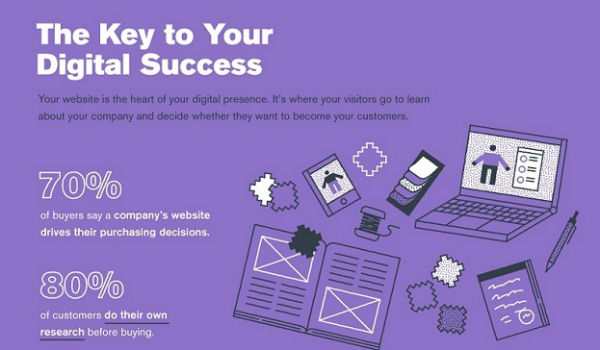
If you're like me, you stay busy.
Running a business is a tall order in and of itself. When you throw marketing into the mix, things can quickly become overwhelming.
If you haven't felt this way yet, you're going to feel it soon: There just aren't enough hours in the day!
Here is one thing I learned early on in my business: outsourcing will save your life.
I speak from personal experience. There's no way I could have done what I've done without strategically and carefully outsourcing a lot of the day-to-day marketing tasks that took up my time and kept me from focusing on other goals.
Why I'm a fan of outsourcing
Outsourcing has tons of benefits.

Most businesses rely on outsourcing because they want to “focus on the core.” That's another way of saying “we want to do what we do best.”
For you, the reasons may be different. You might have 29 things you have to do for a client, but you only have time to do 18 of them. You can outsource the rest.
I'm a major proponent of outsourcing a lot of the day-to-day tasks that are laborious and only hold me back from focusing on more pressing matters.
I'm probably different from other business owners, though. While some people have a top-down or hands-off approach to running their companies, I prefer to be in the thick of it.
You'll see me personally interacting on Facebook, jumping into blog comments, and working on blog articles.
I like to be involved in these aspects of my business because I feel like they are one of my important business tasks-connecting with and learning from other marketers.
That's one of the great things about outsourcing. You can be as involved as you want or as hands-off as you want. It's up to you.
A lot of people I talk with are concerned about the cost of outsourcing. “But doesn't it cost a lot to outsource these tasks?” they ask.
The answer is yes and no.
Yes, you have to pay for quality work.
But no, it doesn't cost a lot because of the time you're saving. If your time is worth, say, $50/hr, doesn't it make sense to pay someone $35/hr to post to Facebook, create a video, proofread an article, or respond to blog comments?
If you can be doing your $50/hr work while your outsourcer is doing their $35/hr work, it's a win-win-win. You win. They win. Your client wins.

And it's not just time you're saving. You're also creating efficiency and increasing your quality. So maybe it's a win-win-win-win-win.
Are there risks to outsourcing?
Sure, there are risks to anything.
I'll admit that outsourcing has its fair share of risks. You can risk hiring the wrong person. You risk an outsourcer going AWOL. You run the risk of poor work standards. You even risk your brand being tarnished when an outsourced worker gets shoddy with their work.
There's a flip side to this.
Most entrepreneurs and marketers are concerned they'll get low quality work if they outsource.
What I've discovered is that you can actually improve the quality of work if you outsource.
Let's say you need to create an explainer video for a new product. You can do it yourself with your iPhone and feeble editing skills.
Or you can outsource it to an explainer video professional.
If you outsource it, the quality will be a million times better than the quality you'd get if you'd tried to do it yourself.
See what I mean?
Besides, you don't always need perfection when it comes to marketing. Although I tend to be a perfectionist, I've realized that done is better than perfect.
But I believe the rewards are greater than the risks. Besides, part of being a good marketer is being a good manager to other marketers.
The great thing is that there is a wide array of virtual assistants and marketing professionals available who will ensure that your campaign runs like a well-oiled machine without you having to hold their hand every step of the way.
Here are some specific tasks you should outsource right away.
Blogging
I always strive to maintain high quality standards on both NeilPatel.com and Quick Sprout. I've found I'm consistently able to do so without it devouring my time by outsourcing.
And I'm not alone. In fact, 64% of B2B marketers outsource their writing in some capacity.
Here are some of the ways you can improve your blog quality through outsourcing:
- Moderating blog comments and filtering spam
- Responding to the comments your readers leave
- Performing research for upcoming blog posts
- Generating new ideas and pitches for blog posts
- Scheduling blog posts
- Finding images and videos for blog posts
- Adding meta descriptions, tags, and images to blog posts
- Finding statistics to incorporate into posts
- Proofreading for spelling mistakes, grammatical errors, and awkward phrasing
- Making adjustments to older blog posts as new data is unveiled
- Creating internal links to existing posts
- Keeping an inventory of posts and the keywords used
- Corresponding with your team of freelance writers
- Hunting down guest blog opportunities
- Coming up with pitches for guest posts
- Reaching out to influencers in your industry
Social Media
In my opinion, social media may be pound-for-pound the easiest area of marketing to outsource.
One of the biggest challenges of social media is curating the content you plan to share. It can take an enormous amount of time simply to find good, relevant articles that your audience will benefit from. Outsourcing this task is an instant way to free up several hours a week!
Think about the importance of visuals in your social media content too. Adding images to individual posts is a massive time drain…unless you outsource it!
A lot of tasks don't require an immense amount of experience. Most virtual assistants are fully capable of handling them with minimal supervision:
- Managing and approving friend or follow requests
- Inviting followers to attend events
- Sending out personalized birthday greetings to key contacts
- Sharing your blog content across social networks
- Finding and editing images to use in posts
- Curating quality content from relevant sources
- Scheduling posts across all social platforms
- Keeping track of brand mentions
- Uploading new videos to YouTube
- Creating questionnaires and surveys
- Engaging with friends and followers
- Ensuring all profiles are updated on a consistent basis
- Sending out thank-yous to new followers
- Commenting, retweeting, and interacting with interesting content
- Designing and occasionally redesigning profiles
SEO
While you don't want just anyone handling the more complex aspects of SEO, there are several elements of SEO that virtual assistants are fully capable of looking after. Many freelancers have the skill to perform keyword research, create a 301 map, or generate a thorough sitemap.
If you're looking for someone to deal with the nuts and bolts of SEO, you'll want to go with a highly qualified SEO firm who has a track record of success.
This post from Kissmetrics discusses what to look for in an SEO firm and how to tell if they're helping or hurting you.
These are some of the SEO tasks that can be outsourced:
- Performing keyword research
- Creating catchy headlines
- Setting up a sitemap
- Building and editing landing pages
- Performing off-site optimization such as commenting on other blogs
- Analyzing the SEO campaigns of competitors
- Tracking the position of your content in search engines
- Researching cutting edge SEO trends
- Submitting content to directories
- Handling social bookmarking
- Monitoring site speed
- Performing an occasional SEO audit
- Keeping up with Google algorithm updates
Content marketing
Did you know that 72% of large organizations and 33% of small companies outsource their content creation?
Content marketing is my jam. I love it. I do it. And I've experienced incredible success with it.
As experienced as I am, I feel completely comfortable outsourcing numerous aspects of content marketing.
Let's face it: content marketing takes serious time. As content marketing grows, you'll discover there are more and more tasks you need to-but don't have time to-do.
You're left with a single choice: outsource or drown.
Here is what you can outsource:
- Creating offsite content that links back to your website and blog
- Interviewing sources
- Finding statistics to add
- Repurposing content, using a variety of mediums such as infographics, videos, slideshows and webinars
- Creating and managing your editorial calendar
- Establishing deadlines for content
- Building spreadsheets for your editorial calendar
- Backing up content in the Cloud
- Finding and editing photos
- Converting files
- Working on increasing post engagement
- Keeping track of your content marketing budget
- Ensuring all content is mobile-friendly
You can learn more about the process of outsourcing content marketing on one of my previous posts. In it, I discuss some important questions to ask to ensure you get the most bang for your buck.
Analytics
Every good marketer makes decisions based on analytics.
But analytics can be tricky. You have to set up your analytics, configure the analytics, generate reports from your analytics, monitor these analytics, analyze the analytics, determine takeaways from the analytics, and then make strategic marketing decisions in light of these analytics.
Thankfully, there are parts of the analytics maze you can outsource:
- Monitoring trends with traffic, acquisition, conversions, etc.
- Spotting long-term patterns
- Generating daily, weekly, and monthly reports
- Analyzing engagement
- Determining how cost-effective your marketing techniques are
Reputation Management
Knowing what the public perception of your business is at all times has never been more important than it is today. In fact, 97% of consumers say they read reviews about local businesses.
Due to the fact that reputation management can be inherently time-consuming, I've found outsourcing it to be a smart move:
- Handling social listening across the web
- Monitoring reviews on sites such as Yelp and Angie's List
- Getting consumer feedback
- Paying attention to negative press
- Responding to negative comments
- Managing trolls
Email marketing
Email marketing matters more today than ever before.
As old-school as it sounds, email marketing is one of the best methods of attracting and retaining high-value leads for your B2B or B2C.
But, as with any area of marketing, things can get tricky here too. Why? Because it takes a lot of time to set up email, integrate it, create updates, format newsletters, and take care of the nitty-gritty of mailing lists and scheduling.
It's one of the first things you should consider outsourcing:
- Creating newsletters
- Proofreading and editing emails
- Sending out bulk emails
- Responding to questions
WordPress
WordPress could be considered the universal blogging and publishing platform.
In fact, 26% of all websites on the planet use WordPress. If you run your site on it, you can make your life a lot simpler by outsourcing a few key tasks:
- Monitoring and managing plugins
- Installing new plugins
- Providing WP support
- Tweaking templates
- Handling coding
Conclusion
We're living in a globalized, digitized world with a surplus of professionals who can handle nearly every aspect of your marketing campaigns.
As a result, outsourcing many marketing tasks makes complete sense and has never been easier to do.
I've had a lot of success with outsourcing, and I know I'm not alone. Many of my industry colleagues and clients have told me the same thing. If it weren't for outsourcing, they wouldn't be in business!
Once you start outsourcing, amazing things will happen to your business.
You suddenly find yourself with more time to focus on high-level strategy. Instantly, you encounter new opportunities for growth and expansion. Your vision becomes clearer. You open up new channels of engagement. Things simply improve.
Outsourcing is a small move that starts the cascade of great benefits.
If you haven't been taking advantage of outsourcing, I would recommend first identifying which tasks are hurting your efficiency and then hiring others to handle them.
Here's my challenge: This week, outsource just one marketing task. That's it!
Use Fiverr, Upwork, or Craigslist. Find someone who's skilled. Give them a task. See what happens.
Have you outsourced any other areas of your marketing efforts that I didn't cover?







 Kevin Jordan is a member of the Duct Tape Marketing Consultant Network and the owner of
Kevin Jordan is a member of the Duct Tape Marketing Consultant Network and the owner of 






